Travel bags seem to be getting better all the time. Long gone are the days of unwieldy suitcases with fussy wheels, and oversized hiking packs with about as much organization as a giant garbage bag. Once you see how much more organized your life can be, you’ll probably never go back.
And there’s a new one that has just launched on Kickstarter, which somehow manages to do things differently than most others. It’s the Slicks backpack, designed for international travelers who want to stay as organized as possible. It’s a modular system, with a lot of features built-in, plus some optional accessories for even more organization.
I was provided with a test sample a few months ago, and now that it’s out, here it is:
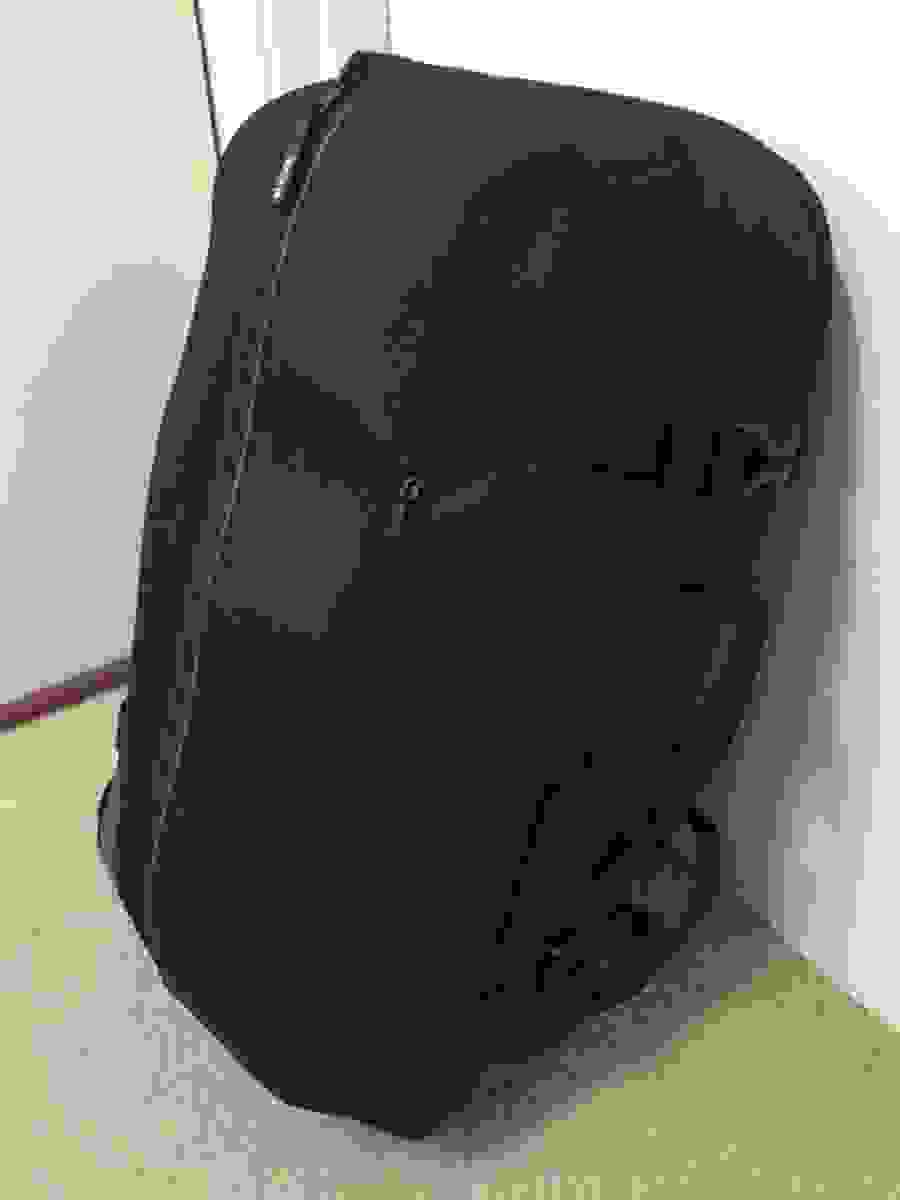
The details:
Dimensions
(Approximate)
- Height: 21″ (53.3 cm)
- Width: 13.5″ (34.3 cm)
- Depth: 7.5″ (19 cm)
- Capacity: 30 liters
These measurements fit within the maximum dimensions for international carry-on limits, which are smaller than what’s allowed on most North American airlines, because Americans always do everything bigger.
The pack actually has a lot of structure built into the walls, using foam padding to prevent it from collapsing or bulging, so there shouldn’t be anything sticking out when the airlines measure it to make sure it’ll fit on the plane (though it does take up a bit of internal space to include those semi-rigid panels).
Weight
This is going to be a little complicated, because of all the optional, removable features, so I’m grouping these items based on how they are sold:
- Backpack (including rain cover): 3 lbs, 6 oz (1.54 kg)
- Tripcover (including all accessories): 1 lb, 6 oz (0.62 kg)
- Suitcover: 1 lb, 9 oz (0.72 kg)
The Suitcover is just a single piece, but the Tripcover includes the following items:
- Packing cube system: 10.12 oz (0.28 kg)
- Toiletry kit: 4.76 oz (0.13 kg)
- Shirt folder: 6.35 oz (0.18 kg)
- Laundry bag: 0.71 oz (0.02 kg)
Don’t worry, there’ll be pictures down below of what all that looks like. So let’s get started.
On the outside
Starting with the back panel, there’s a full range of shoulder, hip, and sternum straps, and a padded back cushion with air channels for some breathability:
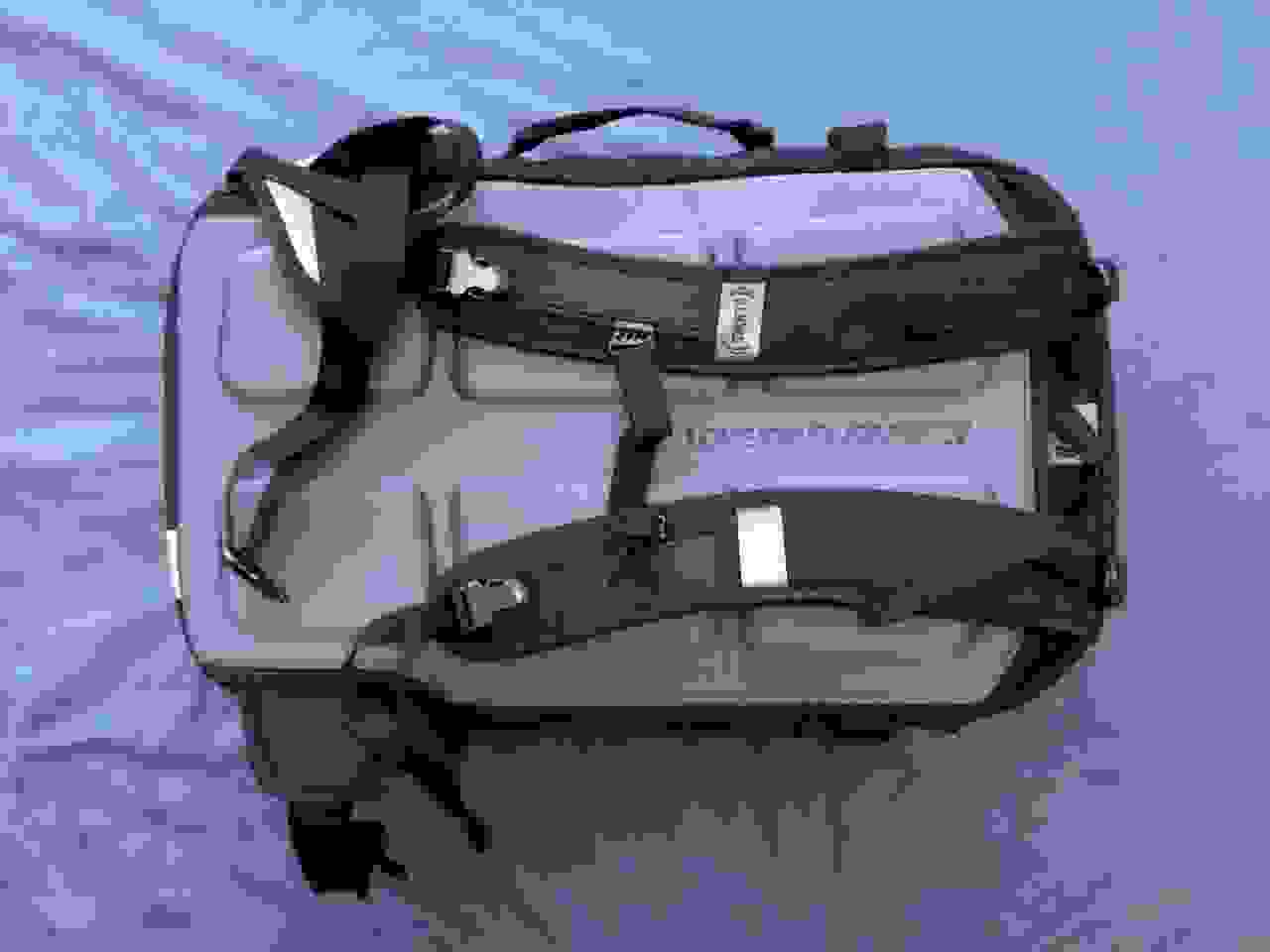
I do like the straps, although I’d like the hip belt padding to be a bit longer; the padded section isn’t long enough to cover the hip bone, so it doesn’t provide much cushioning there. It’s something to keep in mind if you’re planning on carrying it over long distances.
The straps tuck away behind the back panel, like this:
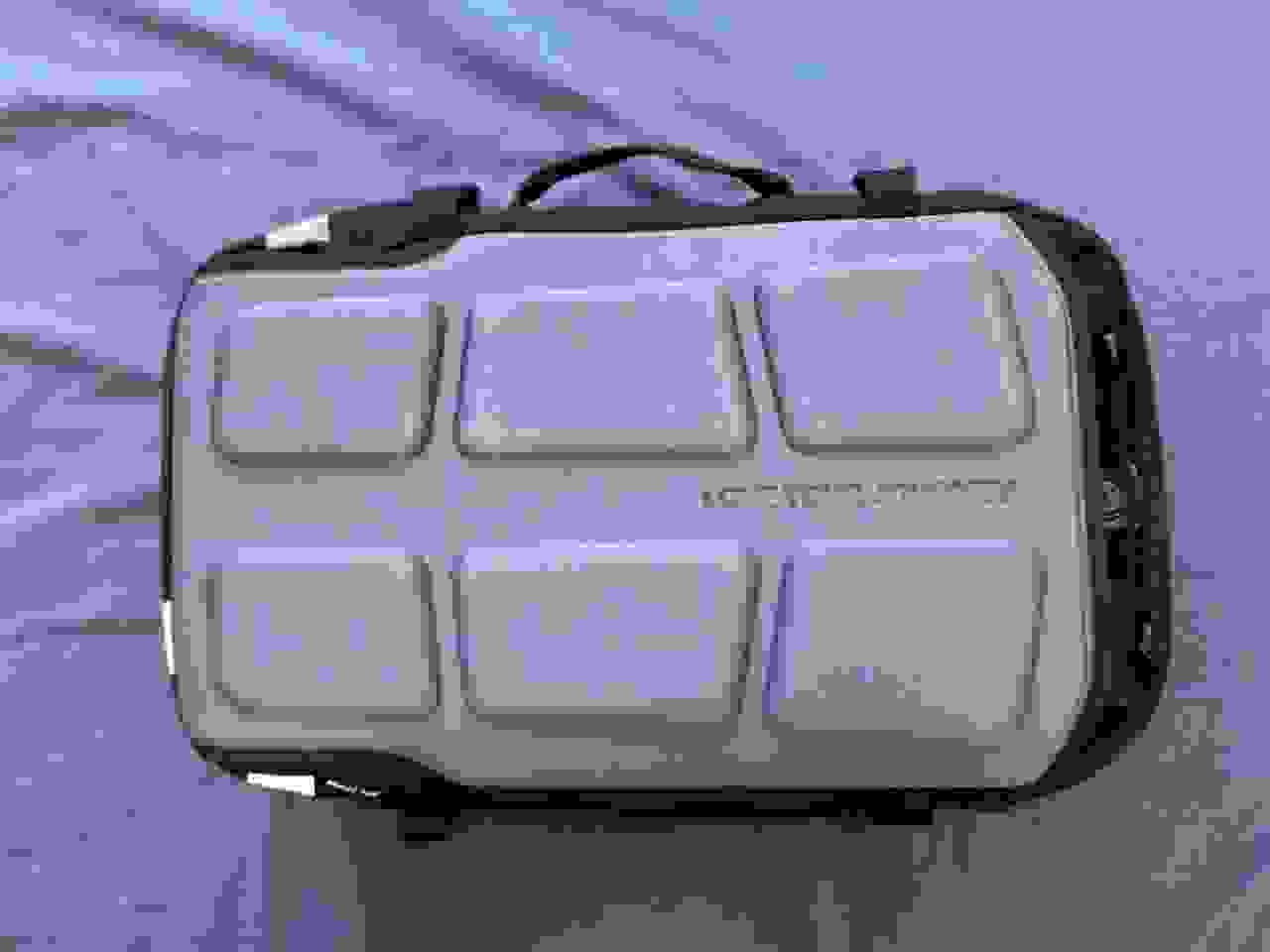
This allows you to use it as a checked bag, without the straps getting snagged on something.
On the top of the bag, there’s a simple, drop-in laptop compartment.
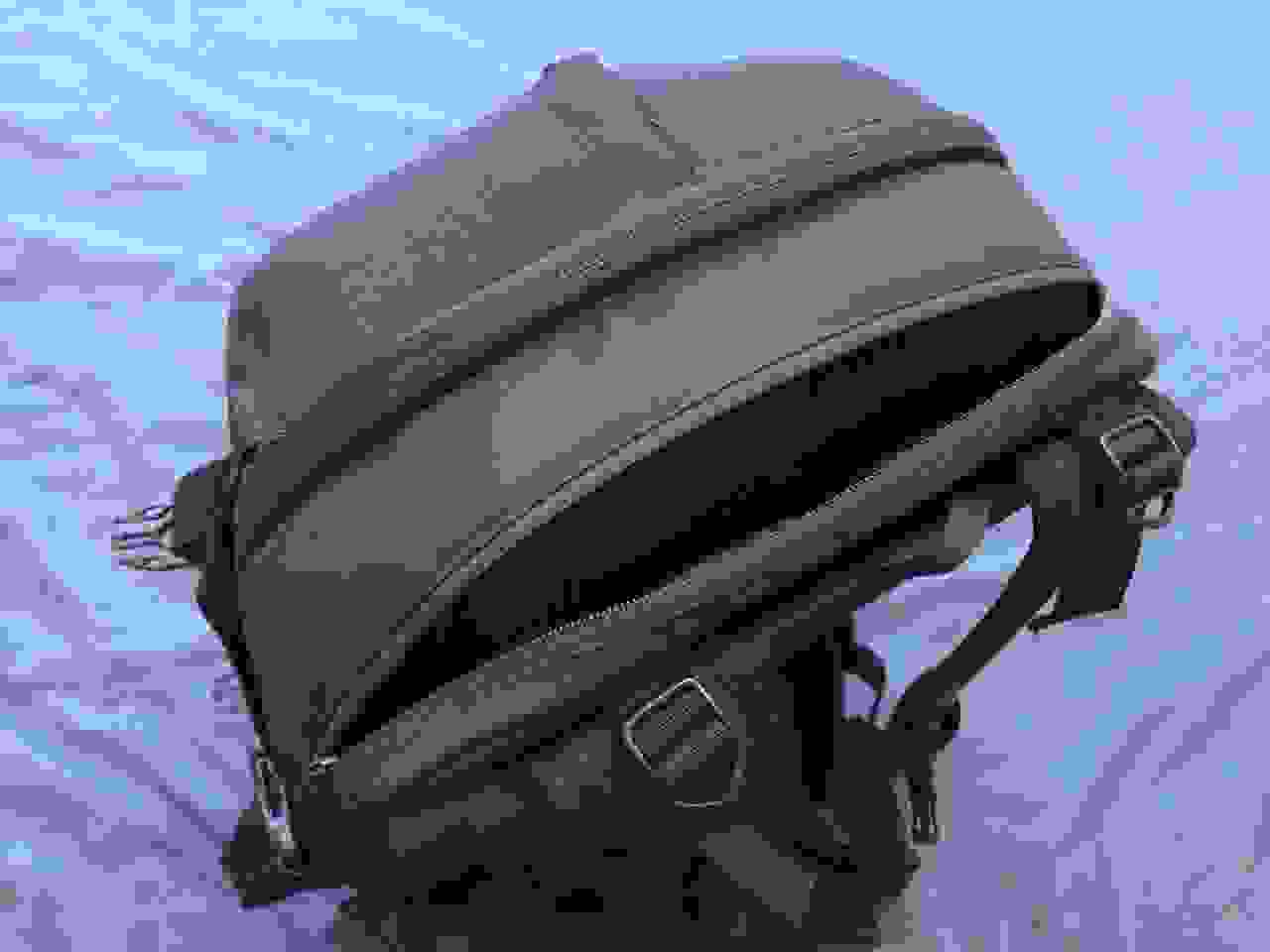
The bottom of that compartment is suspended above the floor of the pack, so if you drop the pack on the ground, the laptop won’t get hurt. The zippers don’t lock, though, so that’s something to keep in mind.
Along the side with the grab handle there are two zippered pockets:
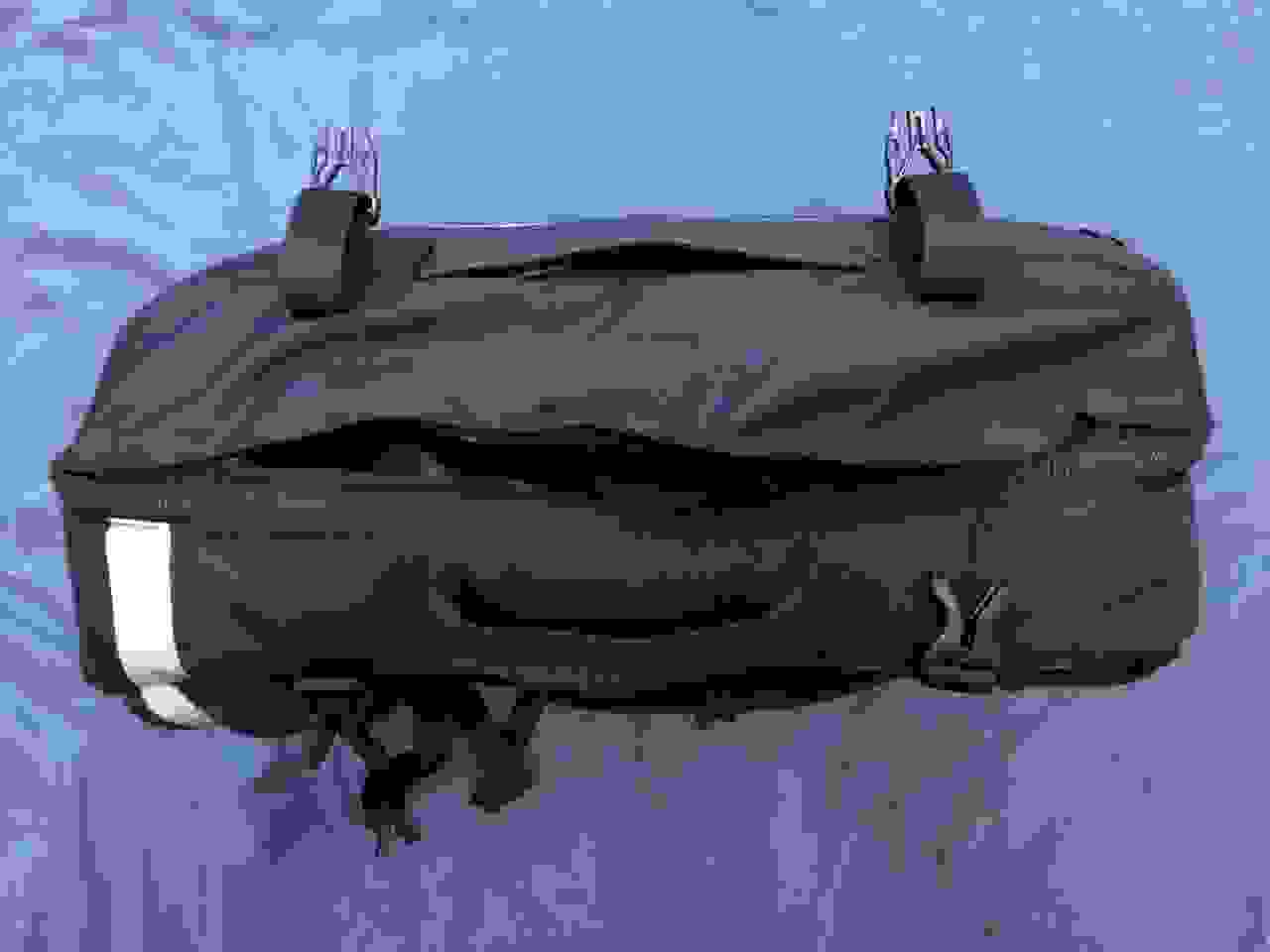
The little one is sized for smartphones, passports, and other things of that size. The larger one is intended for shoes, although because it’s a flat compartment, storing shoes in there will intrude on the space of the adjacent pocket. It’s easier packing smaller, flatter shoes in there, like flip-flops, or boat shoes, especially if you’re filling up the compartment immediately next to it.
Over on the other side there’s another small compartment, with a detachable rain cover.
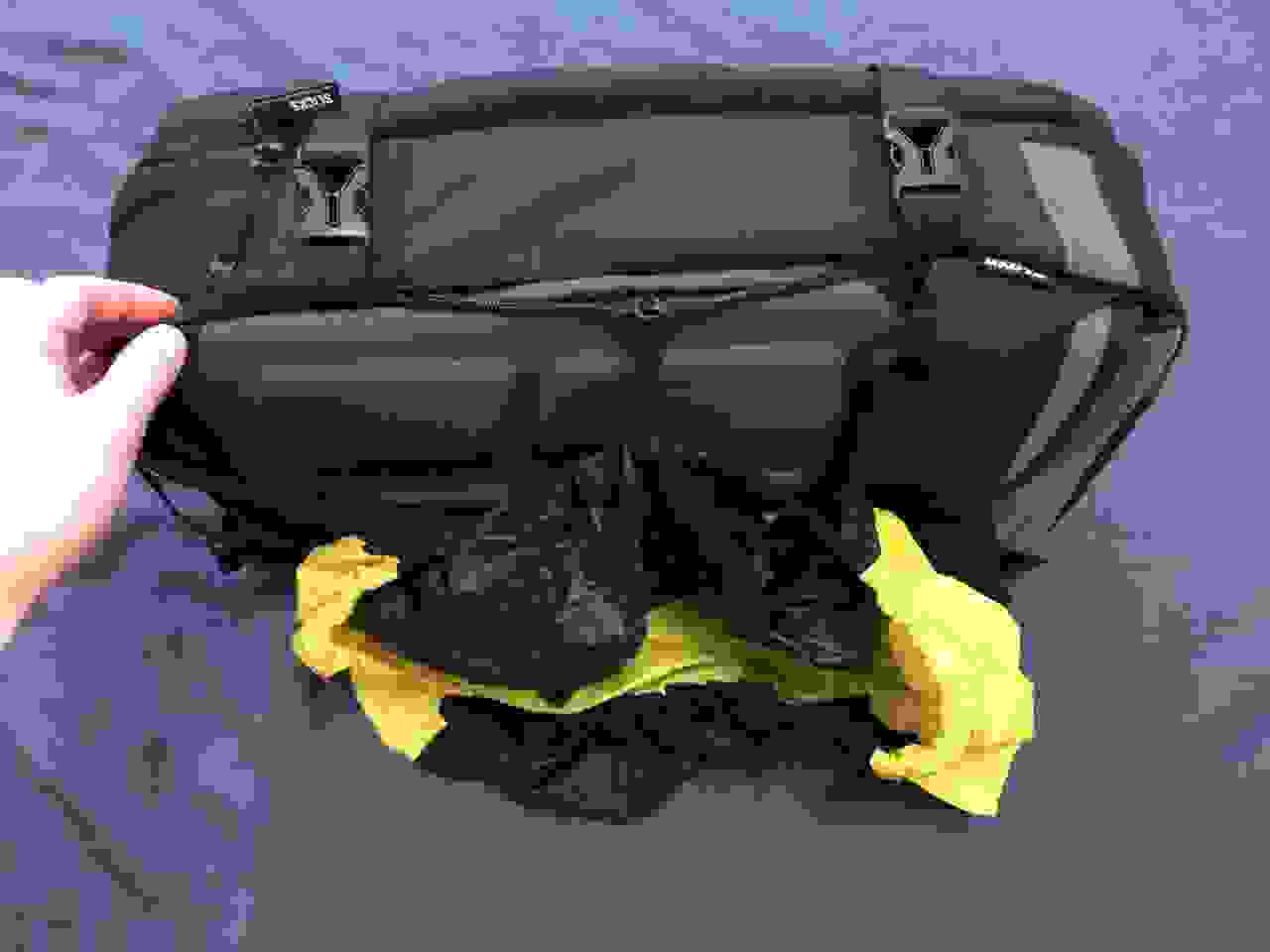
The rain cover even has slots for the hip belt, so it’s quite secure when attached.
Okay, let’s move on to the front. This is where you’ll the only major issue I have with this design, and that’s the central, vertical zipper used to access this compartment:
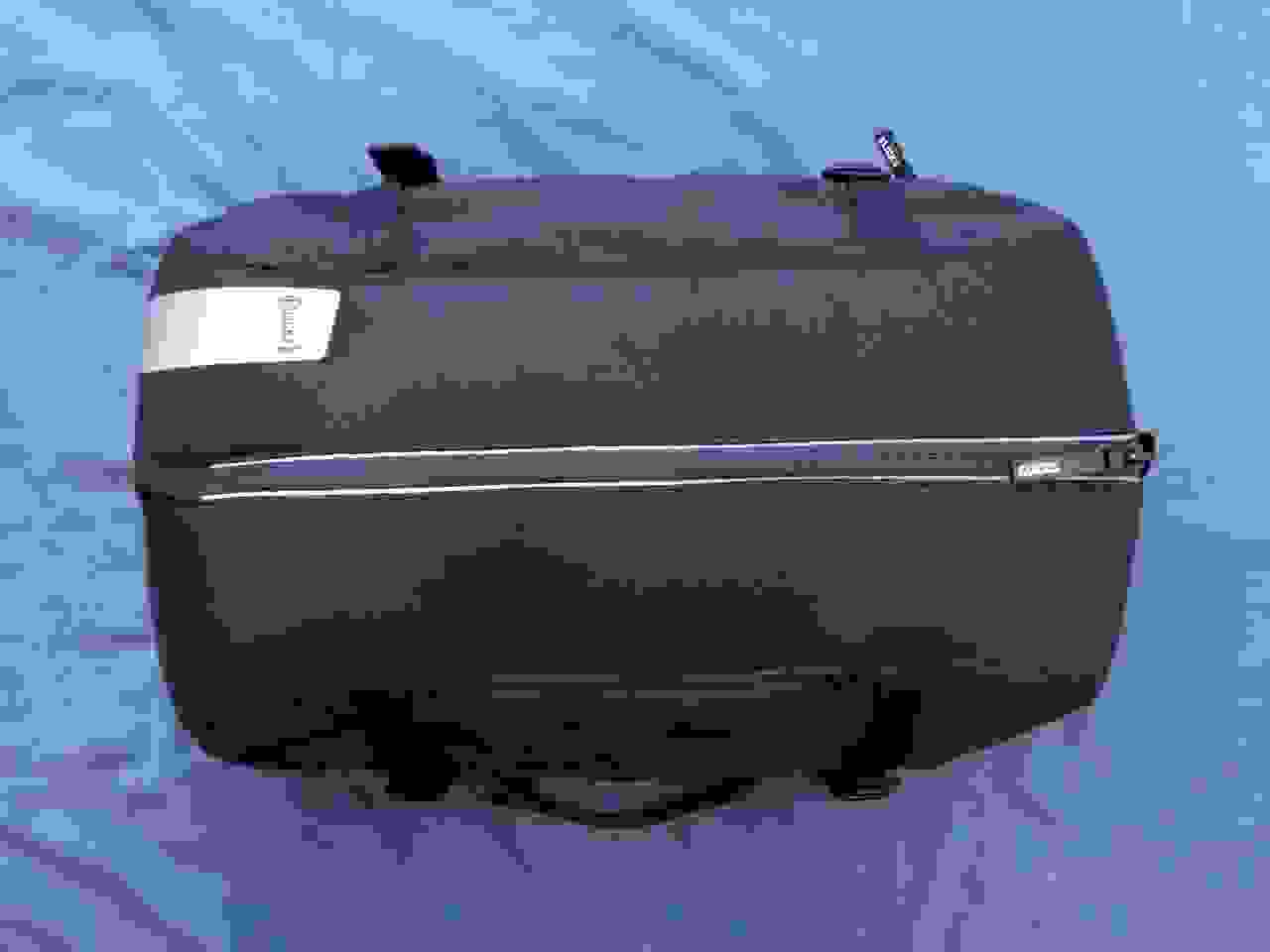
Placing a zipper in a straight line down the middle makes this compartment much more difficult to access. It’s not so easy seeing inside, and it’s especially challenging getting anything into and out of the corners without unpacking whatever’s in the center. It’s also difficult to pack to its maximum capacity, since the more you put in there, the tighter it gets.
Zippers like these work best if you’re only going to use about 2/3 of the space, since you can shove things out of the way and get what you want more easily. It also helps to pack soft items in there, like sweaters or jackets, since you can stuff them in one sleeve at a time, which is still reasonably possible, even if the pocket is nearly full. Long, skinny items are good too, because you can line them up with the zipper opening and pull them out more easily.
I definitely would have preferred a different configuration for this zipper, but it’s still usable. Just tricky to use efficiently.
On the inside
Here you can see a much more accessible layout, which is the suitcase-style opening of the main compartment:
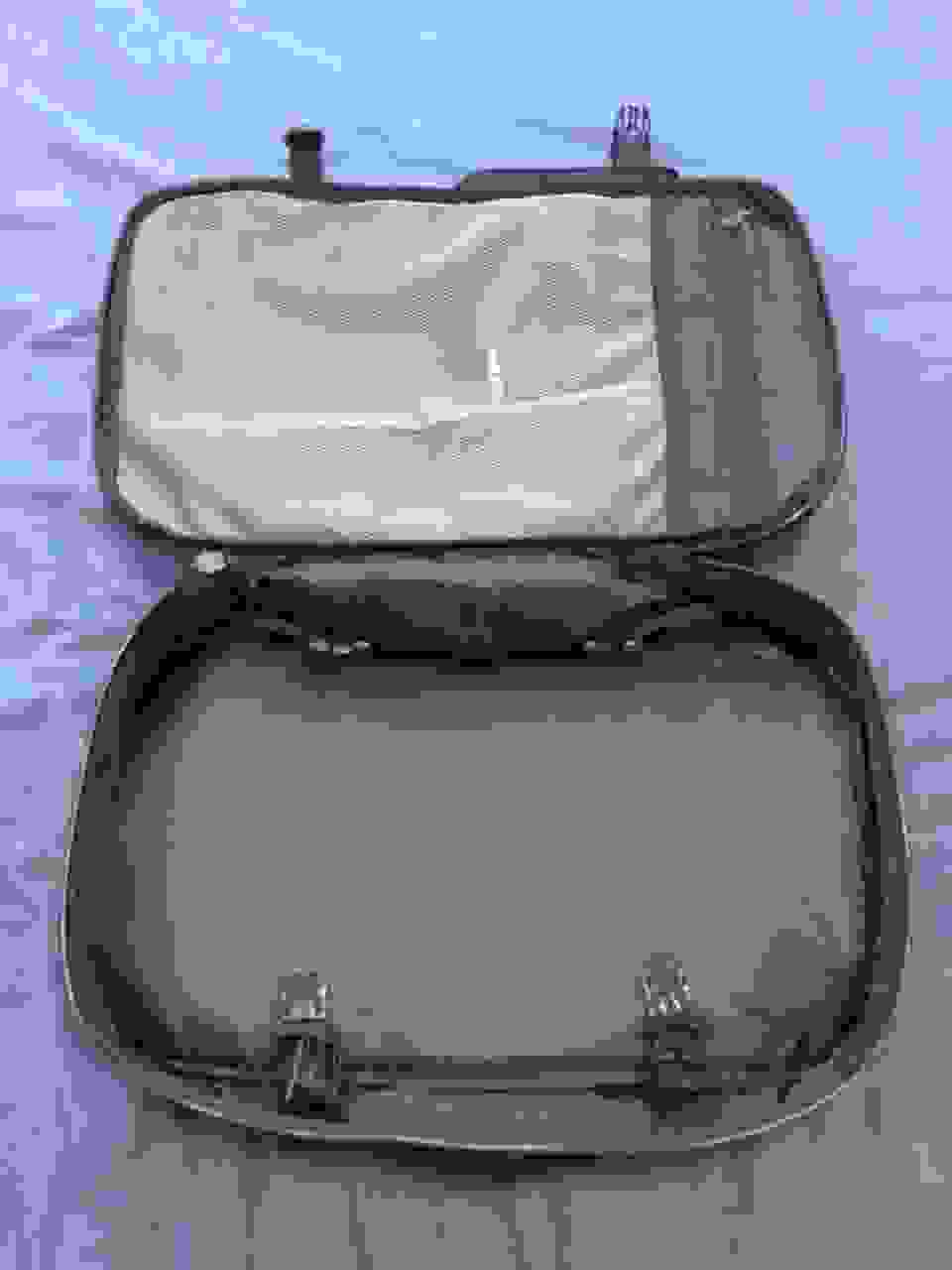
Suitcase-style opening means you can see everything quickly and easily, and packing is less of a chore. This is why I expect hiking packs will gradually disappear from the backpacker circuit, as more and more people realize how much more convenient this is.
In addition to the main packing area, the inside also has these three drop-in slots:
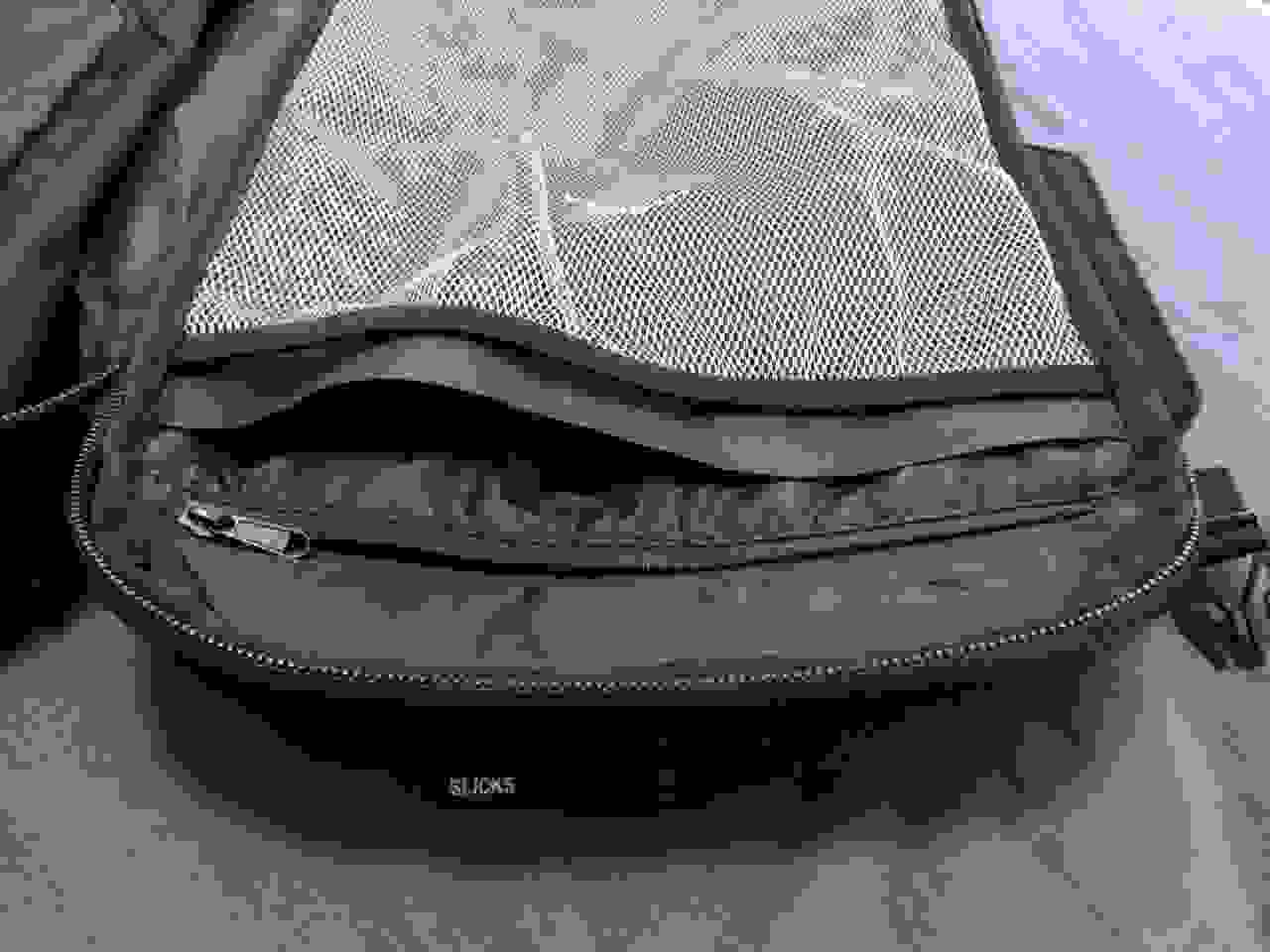
There’s an open mesh pocket, and a velcro-closure pocket, both deep enough for paper notebooks and documents. The zippered pocket is shorter, designed for smaller items, like books or cables. The entire panel is also backed by stiff foam, providing some protection for the documents so they don’t get bent out of shape by the surrounding items.
Accessories
Now we’re getting to some of the unique features of the pack. First is the built-in packing cube system, called the Tripcover:
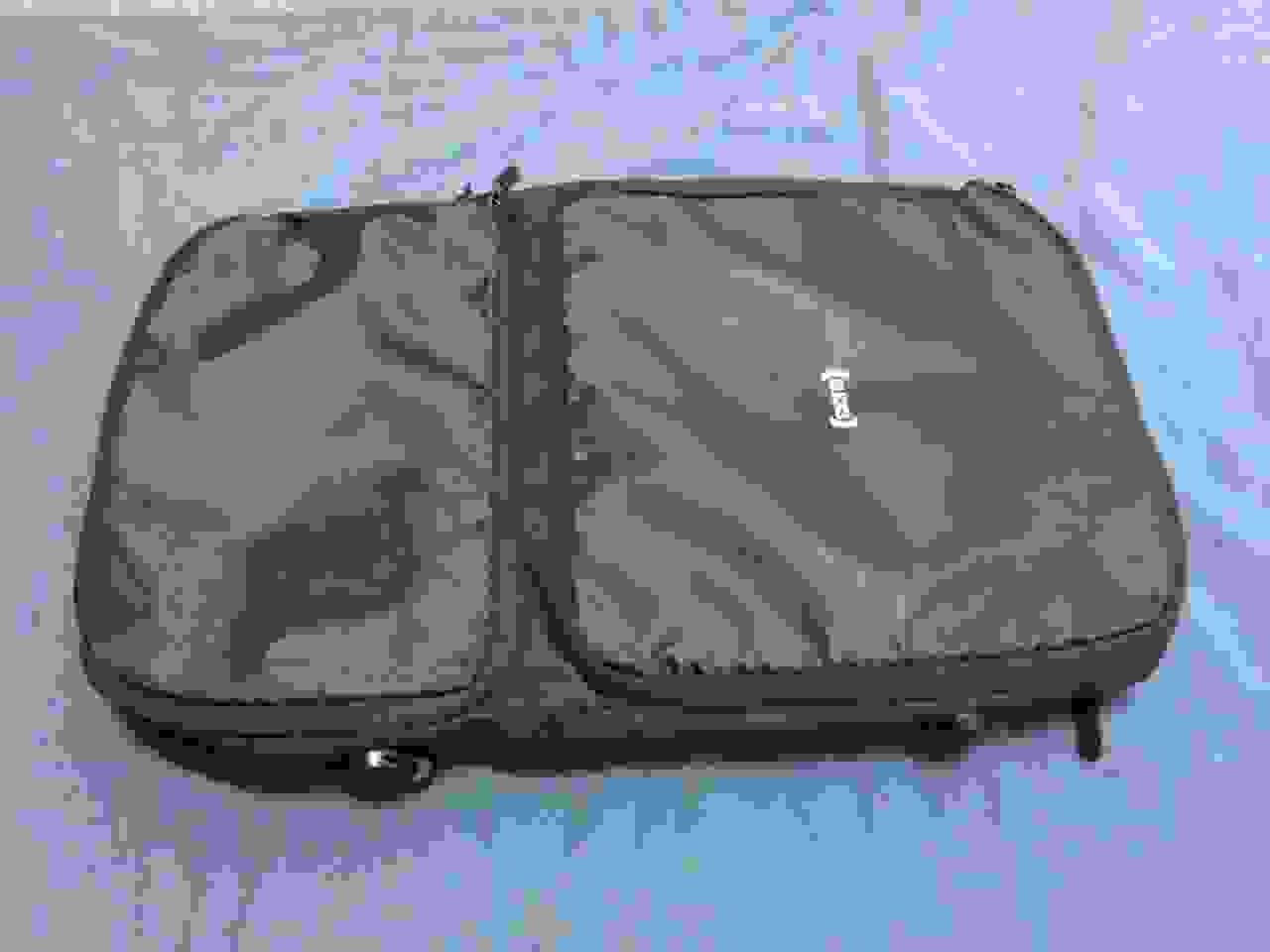
It clips into the main compartment, like this:
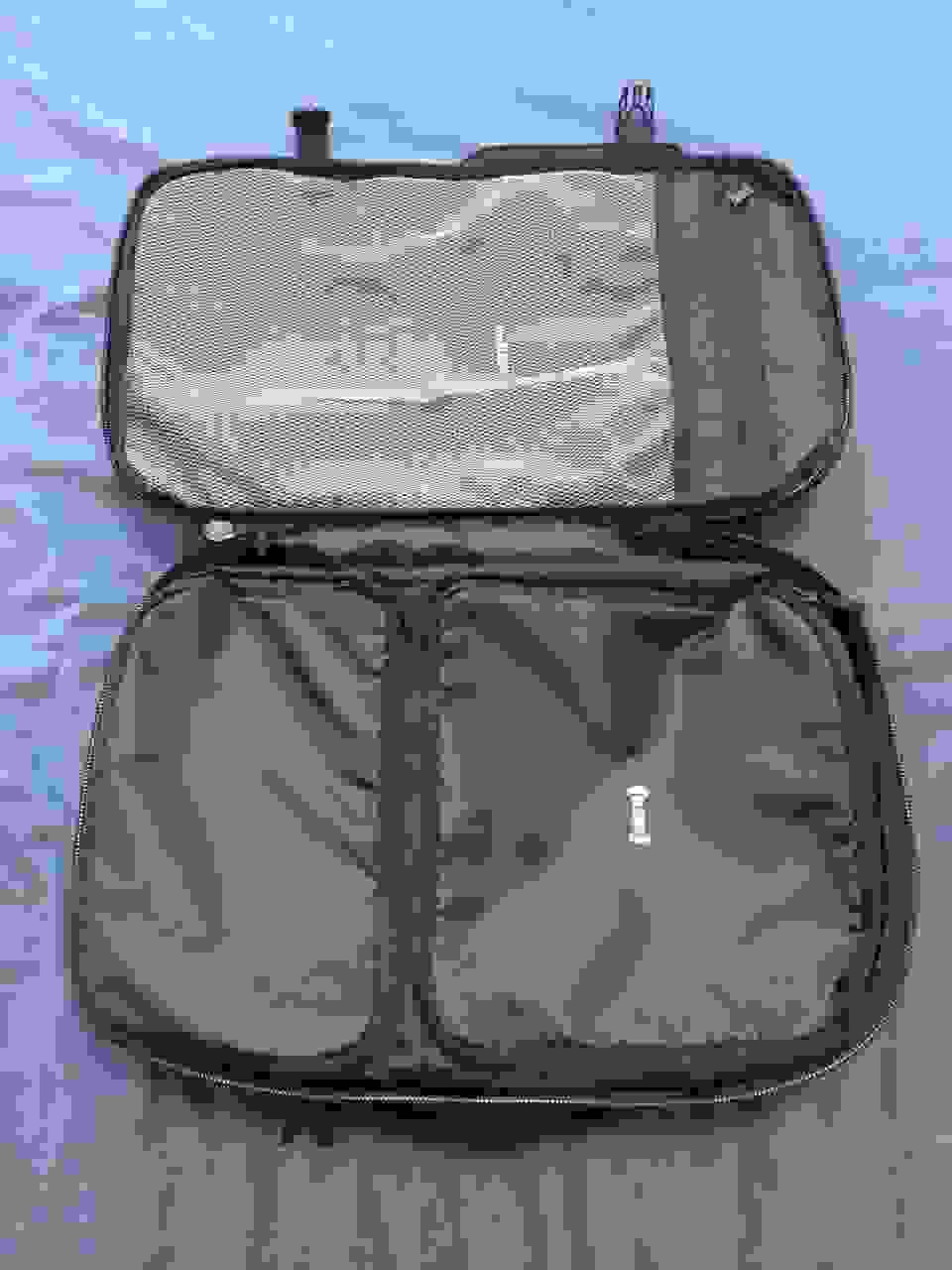
The doors open up just like packing cubes, and there’s a zippered compartment on the back of each door. The smaller compartment contains the included toiletry kit, while the larger compartment is big enough for about four or five changes of clothes, and includes a removable laundry bag:
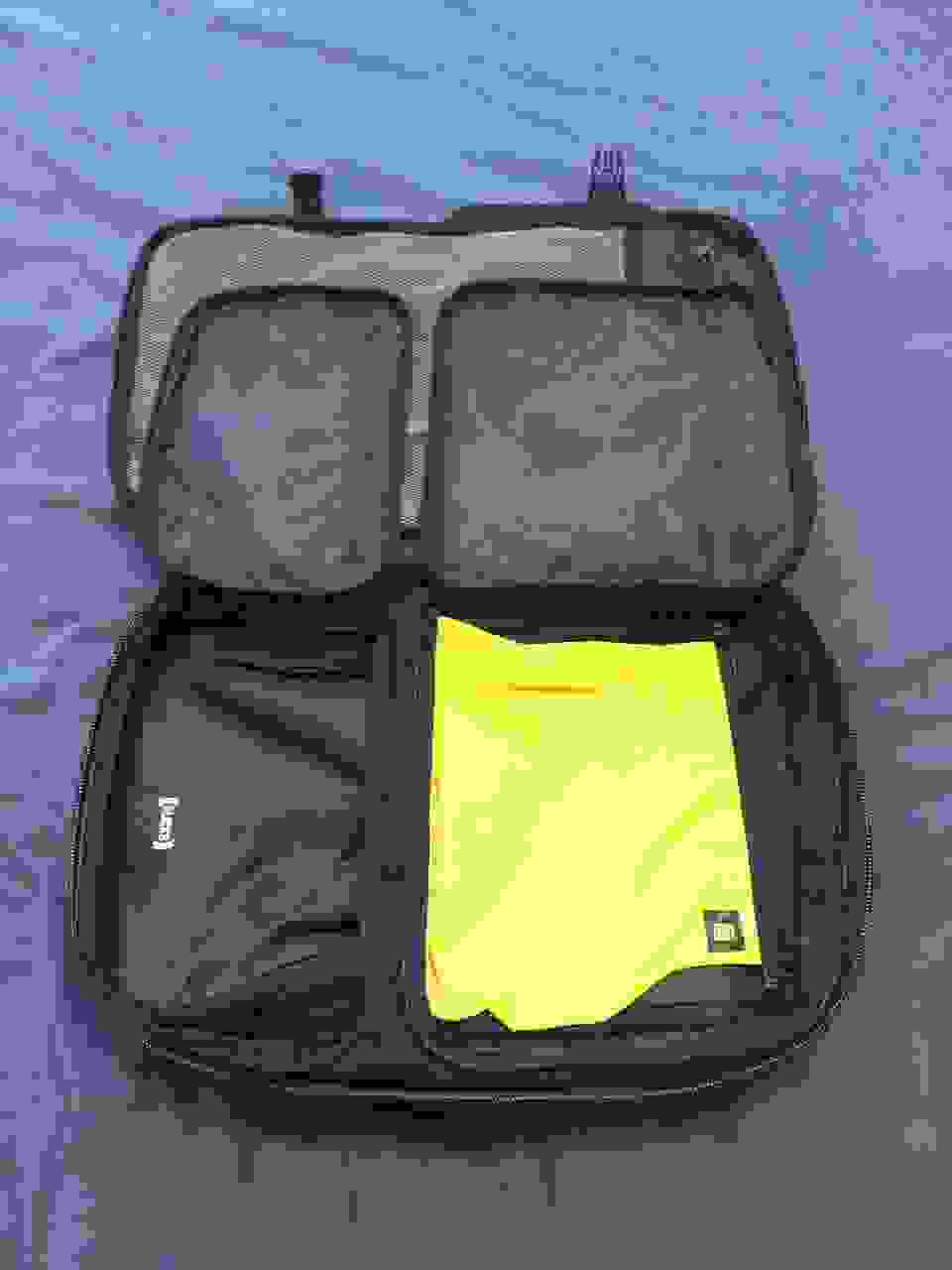
Here’s what everything looks like, all opened up:
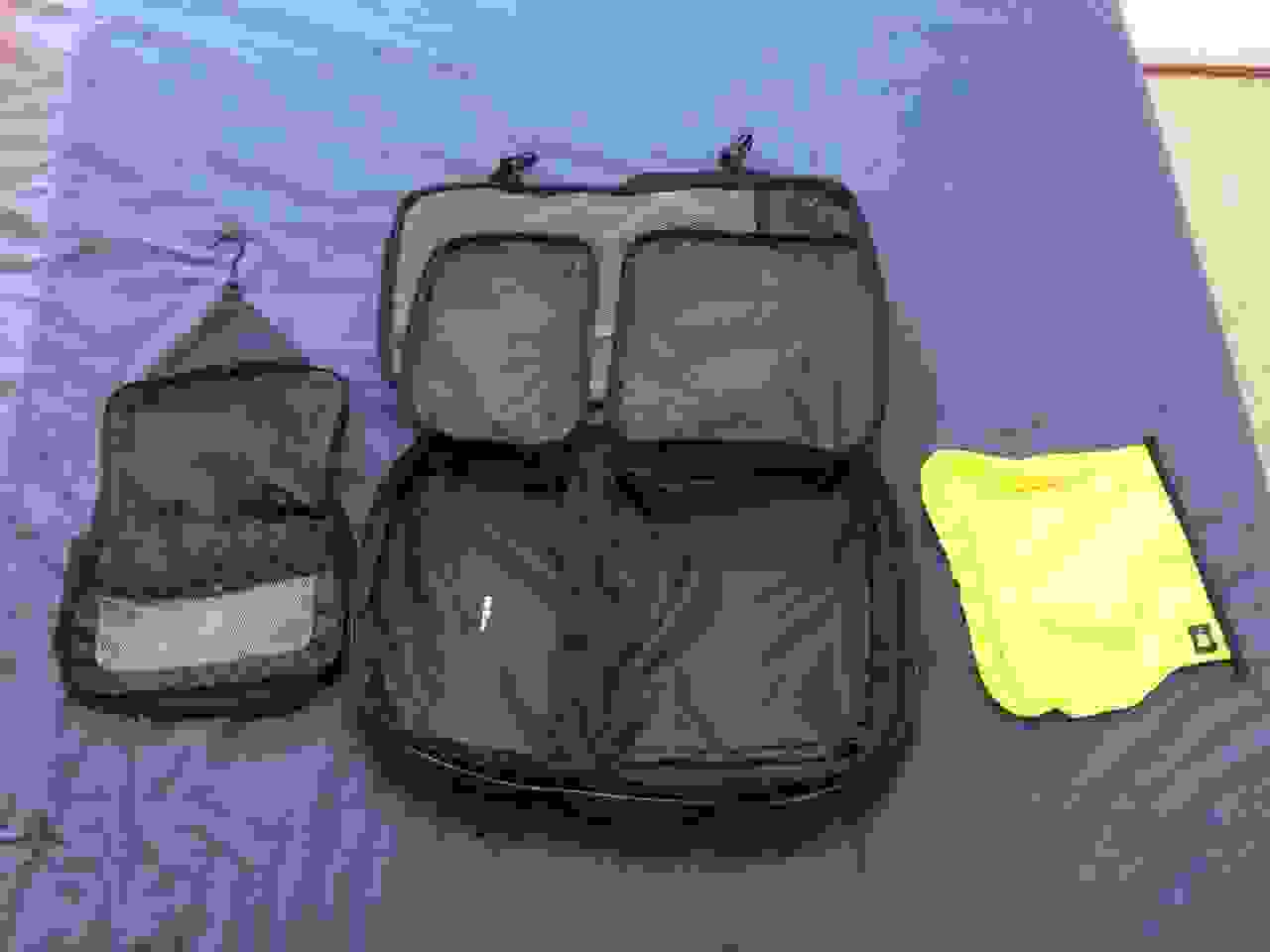
The laundry bag is a really great feature. You know those double-sided packing cubes that store clean clothing on one side, and dirty clothing on the other? This basically does the same thing. You just stuff the used items into the laundry bag (which is clipped in, so it’s always in the right place), which separates them from the rest of your clothing, without needing an entirely separate packing cube to do so. When it’s full, you just unclip it from the pack, and empty it into a laundry machine. It’s really great.
It’s not quite big enough for multiple pairs of pants, but it’s perfect for t-shirts, socks, and underwear, which is what you’d want to keep separate from the rest of your gear anyway. Pants usually don’t get all that dirty, so you can just store them in the same compartment, or maybe in that mesh compartment on the opposite side.
Flip it over and there’s another compartment in back:
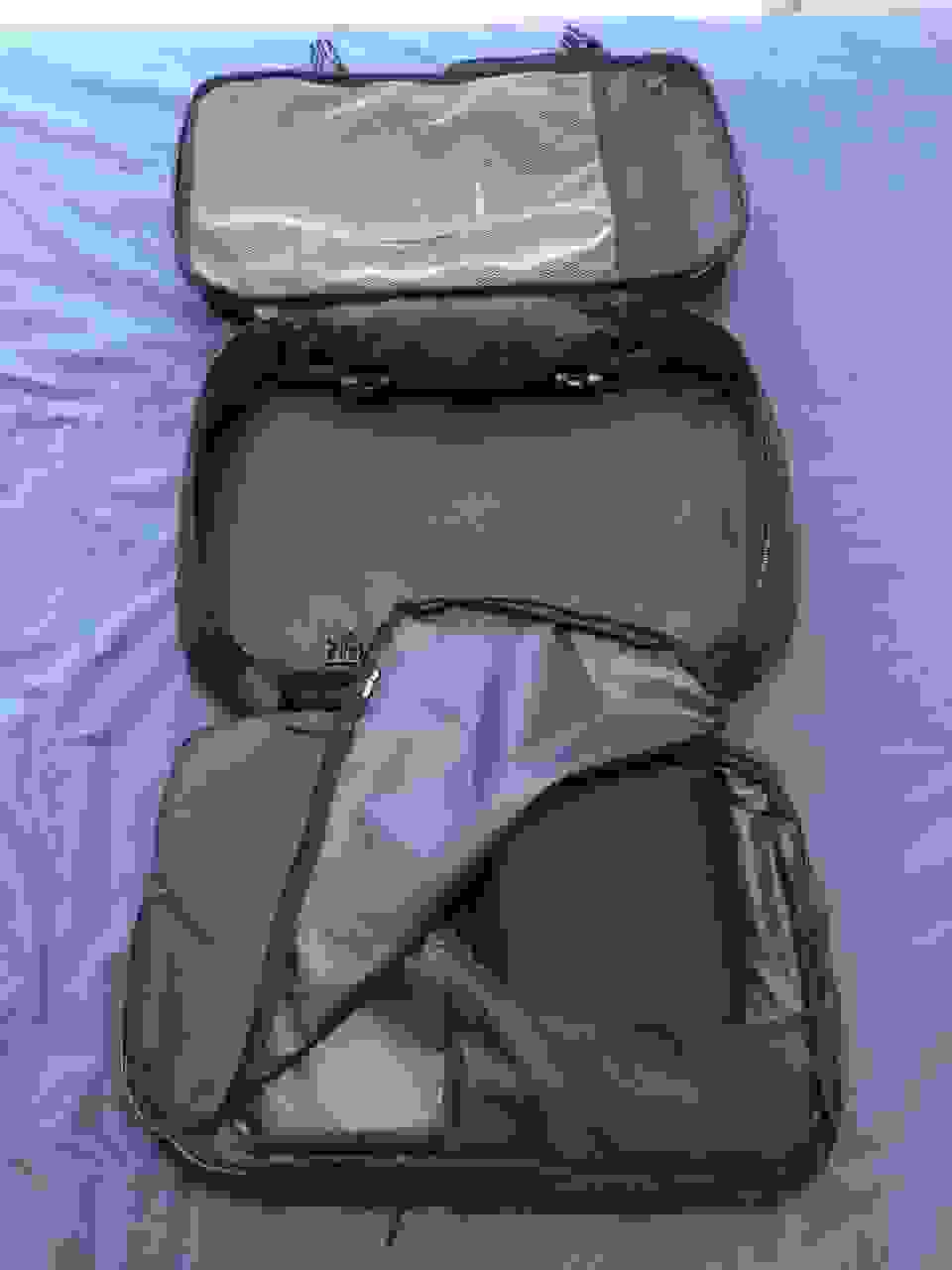
This compartment contains the shirt folder, which is a rigid foam panel with a standing collar protector:

The idea is that you’d fold up the shirt on the rectangular part of the panel, and fold the collar protector over the collar, so it doesn’t get smushed.
It’s quite big, though. Because it arches over the collar, it takes up quite a bit of space in the packing cube on the opposite side. You could pack little things in there along with the collar (coiling a belt on the inside of a shirt collar is a great place to store a belt, and also keeps the collar protected), but it still takes up quite a bit of space. I’d suggest using this only if you have a really nice shirt you need to keep protected, and you’re not taking too much else with you. Otherwise, you can skip this, and store a shirt in that same compartment with the collar folded down flat, instead of raised up.
The pack also has another optional accessory, which is the Suitcover. It’s a hanging, folding suit protector that clips into the pack, underneath the Tripcover, like this:
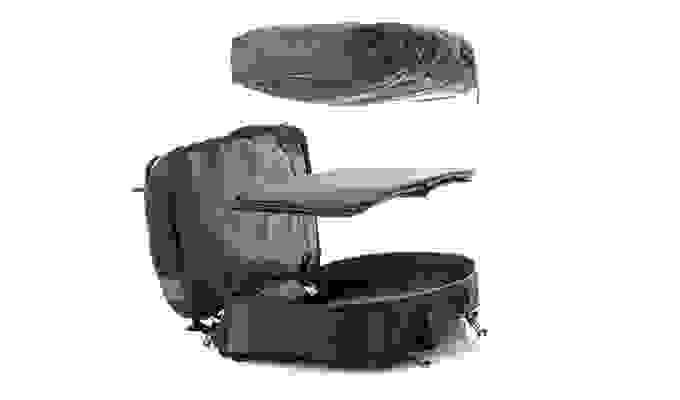
I don’t have this one, but it’s fairly self-explanatory. You zip a suit into the Suitcover, fold it up, and clip it into the pack. When you take it out, it has a built-in hanger to hang it up in your room somewhere. This keeps the suit nicely protected, and helps prevent wrinkles.
I like how all these accessories work together, fitted perfectly into the pack and flipping over or zipping open to give you quick and easy access to whatever you might need, and keeping everything perfectly contained in its place until you need it. It’s really neat to see how it all works, and it’s hard to imagine going back to a giant top-loading hiking pack after something like this.
They do start to get heavy, though. If you’re using both the Tripcover and Suitcover, the grand total pack weight is going to be around 6 lbs, 5 oz (2.88 kg), and that’s before you pack anything into it. But if you’re the type of person that likes to bring a few packing cubes, a toiletry kit, a shirt folder, a suit folder, and a small laundry bag anyway, then it’s not going to be much different in terms of weight. It’s just going to be perfectly fitted.
The pack is quite usable without all those extras, though. Because of the suitcase-style opening, relatively shallow main compartment, and tie-down straps, you can still get pretty organized without adding any of the accessories. Just put small items on the bottom, and cover them with big, flat items on top, and clip the straps to hold everything down:
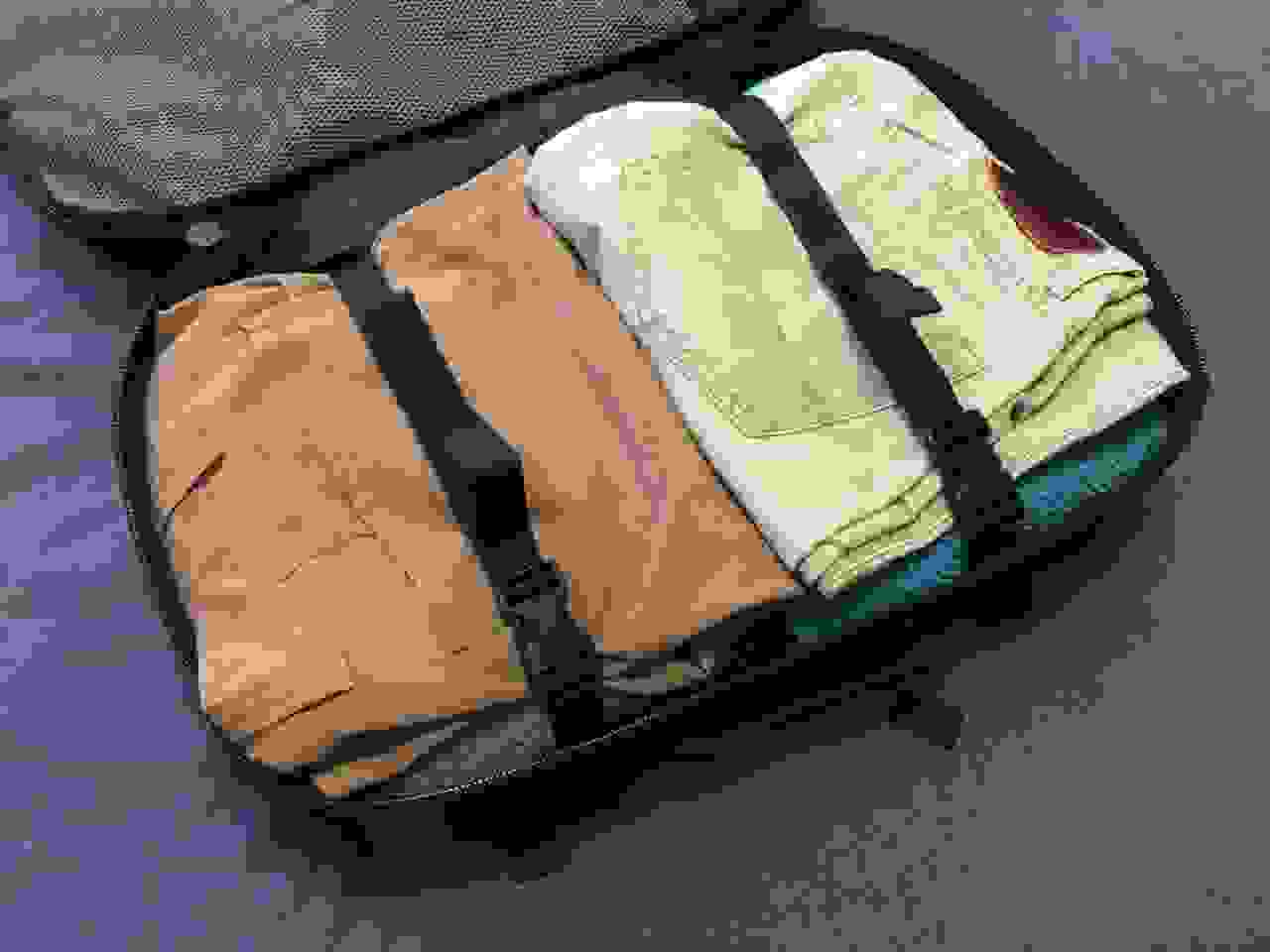
Because this compartment isn’t particularly deep, all you have to do is remove that top layer of clothing, and you’ll be able to see everything in there just fine. This would have been trickier with a deep compartment, but since this one is much shallower, you can do this quite easily.
Conclusions
There’s a lot that I like about this pack, and a lot that it does differently than most others. Those clip-in organizers help keep everything in its place, while several exterior pockets provide easy access without having to open the whole thing. The international carry-on dimensions, storable straps, and suitcase-style opening are great for global travelers, and the semi-rigid walls and compartmentalization means you can use it as an everyday backpack without it collapsing in on itself, and without everything rattling around in one giant compartment. The rain cover and reflective panels are great for bike commuters, too.
There are a few things I’d change, starting with that central, vertical zipper for the outer compartment, which could use a different configuration to make it more accessible. I’d also make the padding on the hip belt extend further, to cover the hip bone, so it’s more comfortable on long walks. I’d like to see smaller buckles on the tie-down straps in the main compartment, as the current ones are quite big. I’d also add some padding to the suitcase grab handle, as it’s currently just a strap. The adjuster buckles on the backpack straps are also a bit tricky to loosen, though that’s not likely to continue being a problem once you get everything adjusted. Locking zippers might be good too. And I might add an all-black rain cover, just to look cool.
But overall, it’s quite clever. There was obviously a lot of thought that went into this pack, and there’s a place for everything.
Head over to Slicks to check it out. It has also been added to Huckberry, so check there for sales too.




Hi Mr. SnarkyNomad
Excellent article as always. I’m a great fan.
Would you kindly consider doing some of your in depth industry standard tests on travel bags that weigh less than a kilogram please.
All those compartments with organizers, and plethora of pockets, are nice to have features, but they add weight, especially when carry-on only allows 7kg. So if the bag weighs 2kg already, it doesn’t matter how big the bag is because you would only have space for say 5kg of your things.
Once again, thanks for wonderful articles, and don’t lose that humour.
Regards
There are some backpacks out there that I like that weigh very little, but they’re definitely going to have fewer features, and they’re usually not going to be travel backpacks. They’re going to be more like regular backpacks for students. Some people travel with backpacks that small, but it’s pretty rare, so I don’t often recommend that to most people.
The Osprey Farpoint 40 is 1.3 kg, although it does a few things that I think are weird (the laptop sleeve is far away from your back, which isn’t the best place to put the heaviest object). But aside from that, you probably have to find much smaller options; I like Tom Bihn’s backpacks, as well as Ivar, as they open up a little more fully and have more compartments than most regular student backpacks.
Also check out the Eagle Creek Systems Go Duffel 35 liter version. 0.96 kg, and it still has some great features.
Eagle Creek Afar 34L – locking zips, 1 lb 11 oz
Osprey Skimmer 30 – 1 lb 12 oz, runs small in size
Osprey Escapist 32 – 2 lbs 4 oz, more features. hip & chest pocket
REI Stoke 29 – top loading, 1 lb 8 oz, hip pockets
Osprey Porter 30 – 2 lbs 8 oz, locking zips
Osprey Tempest 30 – top loading, 1 lb 12 oz
Kanken Maxi – 27L – 1 lb 1 oz. No waist strap but with kanken design that’s ok.
Eagle Creek convertible waistpack/backpack 26L – packable, locking zippers, 12 ounces.
(For those of us who have found that a 40 liter pack encourages too much over packing and you don’t end up really needing half the stuff you bring)
you’re welcome.
Google cuben backpacks. Hyperlite Mountain Gear. Z-Packs etc
Seems to to be similar in size and laid out similarly to the Goruck GR2 34L. Might as well just get one of those??
I mostly like the Goruck designs, but they’re heavy, and the hip belt is weird (it might work fine, but it was obviously a later addition to the design, rather than something built in from the start). Also, you can’t tuck the straps away. That’s fine if you’re always using it as a carry-on, but occasionally the plane will be full and they might ask you to check it. Goruck uses super strong materials, so it’s probably fine, but that’s part of the reason they’re so heavy. Expensive, too…the GR2 is $400. That’s because it’s made in the USA, and I can respect brands that do that, but the price is just going to be out of reach for a lot of people. So I like the layout, but it has some issues that are worth thinking about.
Great and thorough review, yet again. Thank you!
Is there any way you could revisit your backpack comparison article considering the several recent reviews you completed? Maybe include the Minaal, Slicks, Tom Bihn and possibly a Tortuga or something?
Thanks again – keep it up!
I go back and update it every once in a while, so it should be current. This one is only 30 liters and has that central, vertical zipper, it’s slightly more difficult to recommend it to everyone, but I might add it anyway, and mention those potential issues. There’s so much that works well that it might offset those challenges.
The only one that’s missing from that list that’s good is a Goruck, but Gorucks are expensive, and twice as heavy as some of the alternatives…but aside from that, the design is definitely functional.
Perfect! Thank you!
Hey! Wondering if you or anyone else has an opinion on more fashion conscious ‘tech’ options like the outlier bags? I would love a carry on RTW backpack that is best in class in terms of functionality but if it also looked like it was sent from the future that would be great.
Awesome site and review. As I’m traveling to Madagascar this month before the Slicks backpack becomes available, can you recommend a similar brand with the same features. Do Timbuk2 have a modular back pack option like this. Many thanks in advance.
The Hanchor Breccia has a lot of modular features, although the design is different from this one. Timbuk2 has the Aviator Travel Pack, but it’s small and heavy, which I wish weren’t the case.
The lightest functional, convertible, suitcase-style pack I have found is the Rick Steves Classic Back Door Bag (https://store.ricksteves.com/shop/p/classic-backpack).
It weighs in at .9 kg (1.95 lbs). At 41 liters (2500 cubic inches) it is a bit bigger than I need but not overly so. I’d be very happy if they redesigned it down to 30-35 liters. I use Eagle Creek packing cubes for internal organization.
When packed with everything on my packing list, it weighs in at about 6.5 kg. Because of that, I can live without the sternum strap and hip belt. I’ve been dragging this one around Europe and SE Asia for the past 3 years (including 3 weeks in Northern Thailand strapped to the back of my motorcycle) and it shows very little signs of wear. If I was doing a redesign, there are a few things I might consider but not at the expense of adding weight to it.
I have a variation of it listed over on this page. It looks quite nice. Rick Steves always offers good value on his products, and the functionality was ahead of its time, as it’s been around for longer than most of the new alternatives. Glad to hear it’s holding up after all this time.
Hey! Awesome selection of travel bags reviews. Since you mentioned it a few replies ago, can you elaborate your thoughts on the Hanchor Breccia? Or is it going to be featured in a future review? I checked the website and it seems interesting, but there seems to be little to no reviews out despite it being shipped to backers already.
Also, on another note, I would like your opinion on the usage of the Sea to Summit Flow 35L as a carryon bag for travel, and for hiking and camping. It seemed like a good all around bag, except for the usual non panel loading access and organizational ability sacrifices for the waterproofing. I purchased it primarily for waterfall hopping, canyoneering, island hopping and other waterbased activities for day use to an overnight or two. I planned to swim with it to keep my things safe on solo trips. I couldn’t find other bags similar nearby that weren’t just a dry bag with straps. I’m not sure if this question belongs here or in the water proofed bags section, so I hope you don’t mind. Thanks for the awesome blog!
I found this review of the Breccia, which is pretty extensive, but that’s the only one I can see at the moment that isn’t just a product announcement. It looks like it has all the features, though I’d like some mesh on the back panel, and I like the opening method of the Slicks a little better, as it divides the bag into two sections, instead of having just one big compartment, though that’s a pros and cons thing, rather than automatically being good.
I think the Sea to Summit pack looks fine, but I wish those side pockets were taller. I’ve never quite understood how they can be so tiny and still be considered functional…and the compression straps could go along the bottom of the bag, to make room for taller side pockets. But aside from that, it’s one of the few choices out there, and it looks like it has some good features for serious use.
I wish bag manufacturers would reconsider storing the bag straps and hip belt in a false panel on the back of the bag. This practice adds about an inch of thickness to the bag, but much of that thickness is empty.
If the straps and hip belt detached completely, it seems to me they could be stowed in the main compartment without taking up nearly so much room.
Am I crazy, or does anyone else think this could work?
I see where you’re going with this, but the false panel you’re talking about is literally just a sheet of nylon fabric. The back panel padded cushion still has to be there one way or the other, so the only thing that’s there, in order to accommodate stowing the straps, is just a single sheet of thin fabric. Sure, it takes up space, but not very much, and a clip mechanism to attach and detach the straps would probably be heavier.
Awesome site and reviews – thanks for your hard work.
Regarding modular packing. I am pretty new to this, but would I be right in saying the “Bundle” system of packing is thwarted when using modular bags like this?
I guess with Hi Tech materials, creasing is less of a problem so modular works OK?
Any tips for modular packing?
Thanks, Geoff
You are correct. Bundle packing is something you might want to think about for dress shirts and dress pants, but that’s about it. And if they’re synthetic or otherwise wrinkle-resistant, it’s less of an issue. I find it a little annoying to wrap everything inside other things, so I would only bother doing it with fancy dress shirts.
Just received my own slicks. Agree with just about everything in this review, except perhaps I don’t find that central zip annoying – will work well for what I plan to carry in there. That and the black rain-cover comment, but then I’m a cycle commuter so that bright colouring/reflective marking is really important to me.
Having tried several options over the past few years this appears to be the absolute best in commuting backpacks available to a cyclist (assuming you need to transport a suit/business gear on your bike) if you are willing to shell out for it. I can get a full weeks worth of clothing (5 shirts, pair of slacks, shoes, 5x socks + underwear into it plus laptop/documents. (I’m fortunate to have space at work to store this stuff, plus showers etc.
Whilst I haven’t had a chance to commute with it – literally only arrived yesterday afternoon – the weight feels very balanced on my back. Excellent shape and design. Hopefully means I can ride 3 days without a bag at all! Mon = gear in, Fri = gear home. Won’t use the suit cover much, but there are 2-3 times a year that will be handy for work.
Sounds like you’ve found your favorite. I really like the design as well, and it does some things you can’t find elsewhere. I prefer the way the main zipper opens, kind of like a book, rather than opening up lengthwise so that it’s really long when opened up.